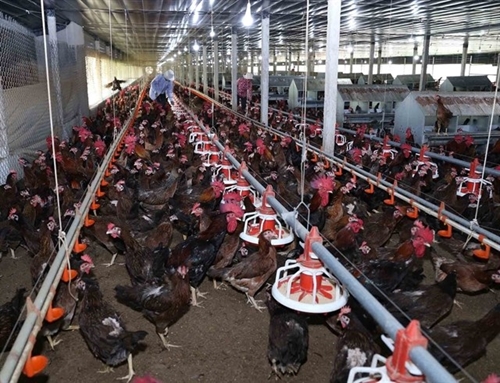Nguyen Thanh Son, Chairman of the Vietnam Poultry Association, said Vietnam’s signing of several free trade agreements has created chances for local firms to approach new markets with great potential.
To compete in export markets, Nguyen Quoc Toan, acting director of the MARD's Agro Processing and Market Development Agency, said local enterprises should identify target markets and consumer tastes of potential import countries to ensure they introduce products that meet demand. For instance, firms should boost exports of chicken breast because the product is favored by consumers in export markets, while chicken thighs and wings are popular in the domestic market.
    |
 |
|
A poultry farm in the Central province of Binh Dinh |
Target markets of Vietnamese firms for chicken meat exports include Japan, China and the Philippines. Potential markets include Saudi Arabia, South Africa and the United Arab Emirates (UAE), according to Toan. Meanwhile, firms should focus on exporting poultry eggs to traditional markets in Northeast and Southeast Asia.
Despite plentiful supply and high import demand, exporting poultry products is not easy because of technical barriers and strict food safety and hygiene controls in import countries, Pham Van Dong, Head of the Department of Animal Health told Sài Gòn Giải Phóng (Liberated Saigon) newspaper.
He said the ministry has spent two years negotiating with Japanese authorities about exporting Vietnamese chicken meat to Japan. At present, although they have received approval from Japanese authorities, each batch of poultry products from Vietnam has to be kept at a Japanese veterinary agency to check for pathogens and antibiotic residues.
Therefore, if firms want to promote exports, they must invest in closed-loop production or apply modern processing technology, he said. In addition, they should strictly control diseases and avoid the use of antibiotics and banned substances in farming. If there is an outbreak of a disease, export of poultry products could be halted and firms would lose market share, he said.
Nguyen Xuan Duong, acting director general of the MARD's Husbandry Department, said that in order to have safe and modern livestock production, the industry should gradually reduce small-scale animal husbandry facilities and increase large livestock farms.
The ministry should encourage building VietGAP breeding facilities to establish safe farms and create favorable conditions for the local husbandry industry to move towards international integration and exporting poultry products, he said.
Minister of Agriculture and Rural Development Nguyen Xuan Cuong has proposed the State create favorable conditions for enterprises that export poultry products to expand production and receive quality certificates. These steps would help the enterprises approach demanding markets around the world.
Duong said poultry farming has recently seen a shift from small-scale farming to intensive farming. Productivity and profits are both increasing, turning poultry farming from a secondary occupation into a main job in agricultural production in some places.
In recent years, the number of poultry has increased by an average of more than 6 percent annually. By 2018, output exceeded 1.1 million tonnes of poultry meat and 11 billion eggs.
At present, farmers across the country are raising around 409 million poultry animals, of which chickens account for 77.5 percent.
Cities and provinces that have shown strong development in poultry production include Hanoi, Ninh Binh, Quang Ninh, Binh Duong and Dong Nai.
There are currently two main models of farming: intensive farming and household-farming. Intensive farming has been developing rapidly with 10,000-12,000 farms, mainly in the Red River Delta, the Southeast region and the Mekong Delta.
For decades, the domestic husbandry industry has produced poultry products mainly for the local market, according to the ministry. However, as supply has increased, the industry has begun to consider export markets.
In the past three years, some firms have started exporting poultry products to other countries. Export value of poultry products has shown rapid growth. Poultry exports exceeded USD 3 million in 2016, climbed to USD 5.6 million in 2017 and reached more than USD 18 million in 2018.
Poultry products produced in Vietnam include fresh duck eggs, salted duck eggs, processed chicken meat, canned quail eggs, egg powder and braised black-bone silky chickens.
Every year, the country exports between 1.25 million and 1.5 million breeding poultry and around 10-15 million salted duck eggs. Export of chicken meat started in September 2017 and reached nearly 8,000 tonnes of processed chicken meat in 2018.
Source: VNA